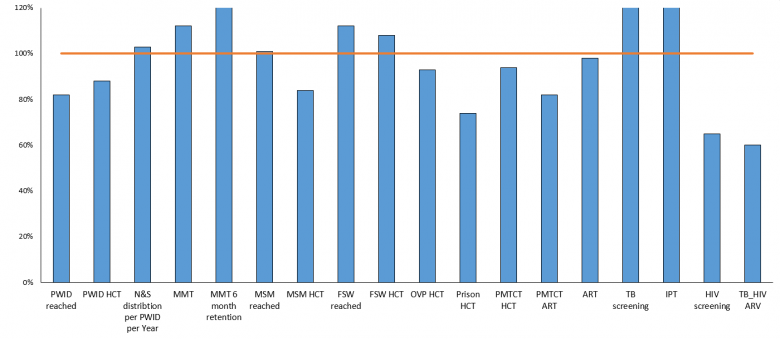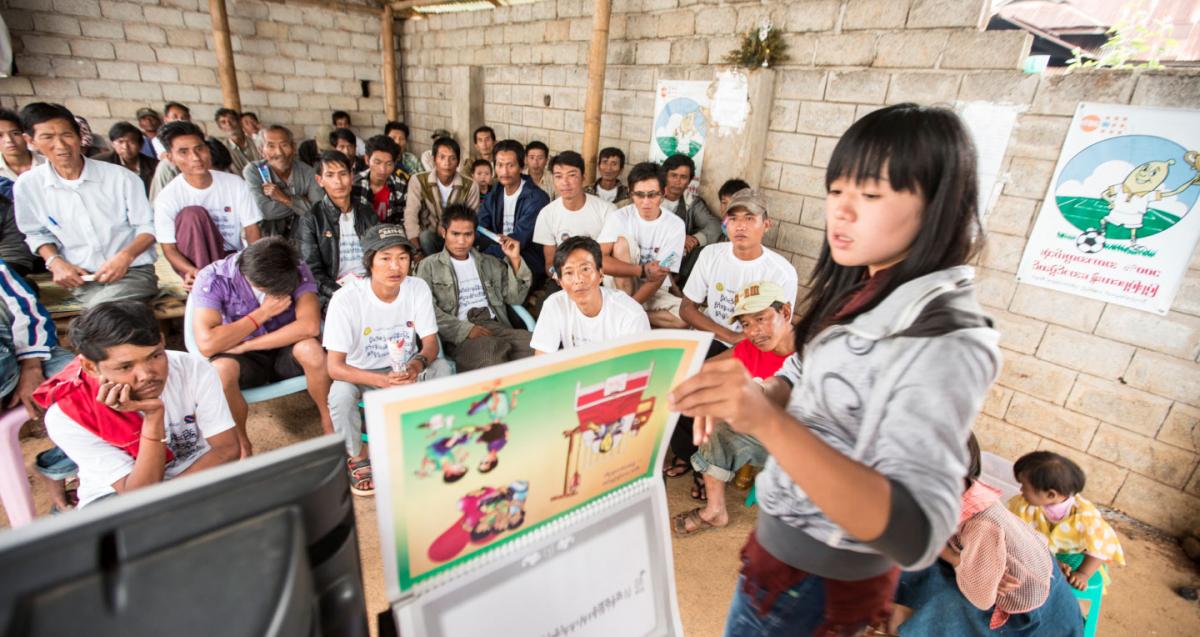
The cumulative results for 2020 are shown as a percentage of the annual target. The indicators on sex workers, men who have sex with men, and people who inject drugs reached, along with HIV counselling and testing and TB status assessed, are funded by GFATM only, whereas the others are funded by GFATM and other donors.
In 2020, the COVID-19 pandemic caused much uncertainty around the world, including for people living with and affected by HIV. It also brought up many challenges in the way Programmes were implemented. During the COVID-19 pandemic, PR-UNOPS was working closely with the public sector service providers and implementing partners to maintain prevention, care and treatment services while undertaking COVID-19 infection control measures so that the interventions were ensured not to be interrupted.
In addition to the measures of infection control at the service provision sites, one of the major challenges faced was logistic and supply chain management, which could be supported in all possible ways and made sure that adequate quantities of ARV and other medicines supplies are in the country as well as reached the service delivery sites.
Implementation approaches were also adopted to be in line with the needs at the ground level and could provide Multi Month Dispensing of ARVs to the PLHIVs, and provision of take-home doses to the majority of the Methadone clients. In addition, clients were also allowed to access services at the nearby location in case of lock down or travel restriction, to assure continuation of service.
During 2020, 6 out of 18 reportable indicators either meeting or exceeding 100 per cent of the annual target.
By the end of 2020, 176,173 people living with HIV were receiving antiretroviral therapy (ART) (98% of the planned target for the year). There have been challenges that PLHIV’s access to Antiretroviral treatment (ART) was disrupted due to travel restrictions in some States/Regions where people cannot cross townships to receive the treatment. In these cases, ARVs were delivered to the Township border so that clients could have easy access to it. Moreover, Multi-Month Dispensing of ARV was practiced to prevent disruption of ART in case of a full lockdown.
In 2020, 899,661 (94% of target) pregnant women received HIV counselling and testing and knew their test results, and 82 per cent of HIV-positive pregnant women received antiretroviral drugs to prevent mother-to-child transmission of HIV (PMTCT) provided as part of a package of antenatal care services offered to all pregnant women at public health facilities in Myanmar.
In 2020, 27,313 (101% of target) men who have sex with men (MSM), 29,036 (112%) female sex workers (FSW) and 20,826 (82%) people who inject drugs (PWID) were reached with HIV prevention services. In total, 22,435 (108%) FSW and 20,308 (84%) MSM underwent voluntary HIV testing and received their test results and post-test counselling. During the year, 22,136 (88%) PWID consented to HIV testing and received their test results.
At the end of 2020, 26,016 (112%) PWID had been enrolled into methadone maintenance therapy (MMT) in 86 MMT sites across the nation, and 73.9 per cent of persons who enrolled in MMT continued the treatment for at least six months. To ensure uninterrupted Methadone Maintenance Therapy (MMT), implementing partners practiced take-home methadone dosages to reduce the frequency of visits to the MMT Center by the clients while practicing physical distancing among the clients and infection control measures.
In terms of needle and syringe distribution to PWID, the equivalent of 397 (103% of target) needles and syringes per person were distributed in 2020.
In 2020, 41,989 (93% of target) of other vulnerable populations (OVP) consented to HIV testing and received their test results and post-test counselling.
During the year, 8,453 (65% target) new HIV-positive patients started isoniazid preventive therapy (IPT).
Some 74 per cent of people (82% of target) living with HIV who had TB co-infection had been enrolled on ART by the end of the year.
During the year, 95 per cent (96% of target) of HIV patients were screened for TB during their last visit, and 97 per cent (108% of target) of TB patients had their HIV status assessed and documented.


